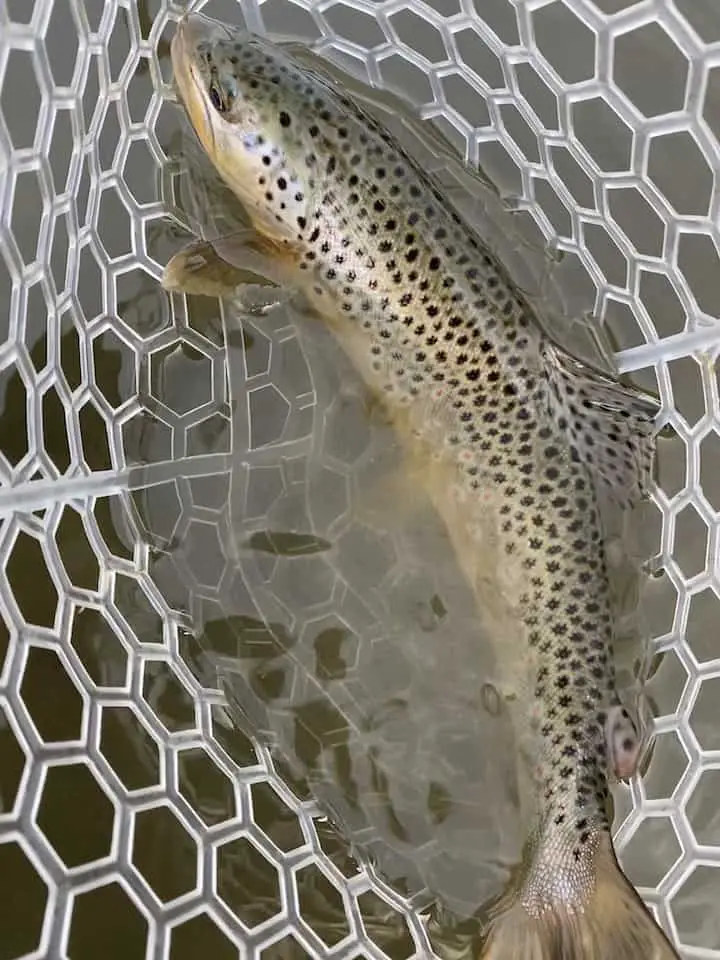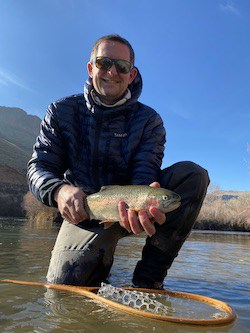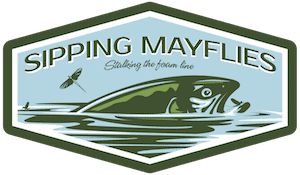Fly Fishing Muddy Water and Spring Runoff
Feb. 12th, 2022
Fly fishing muddy water doesn’t have to be a frustrating experience. You might look at the discolored river and think angling would be pointless because the fish wouldn’t even be able to see your fly six inches in front of their head, but you’d be wrong. Fish don’t just use their vision when hunting for prey (more on this later).
Based on my experience, I’ll teach you how to bring plenty of fish to your net in muddy water and during spring runoff, including trout, bass, carp, and more.
An extra bonus is that you’re likely going to have the entire river to yourself, because most folks don’t know how to fish dirty water. This means you can cover a ton of river and optimize your strategy. Let’s dive into the article.
How Muddy is Too Muddy?
There’s actually a difference between “muddy” water and just dirty or discolored water.
Truly muddy water, often referred to as “chocolate milk” by fly fishing guides, does make fly fishing much more challenging. Bait fisherman can use scents to help the fish find their hooks in these conditions, but fly anglers don’t have that option.
Chocolate milk rivers are generally caused by heavy spring runoff. In other words, melting snow in the mountains flowing into your river, along with sediment.
If you can’t see your hand six inches under the surface of the water, your time is probably better spent doing something else.
But if the water’s just cloudy and silty, no problem. I’ve got solutions for you.
Some of the best rivers I’ve ever fished are frogwater rivers. Frogwater is murkier water. It can make for some excellent fishing if you know what you’re doing. And you will, because you’re reading this article.
Here’s a brown trout I landed in dirty water. I couldn’t see the bottom of the river where I was fishing, but the trout were finding my flies.

What Causes Muddy water?
Muddy water can be caused by a number of factors, including rain, snowmelt, and dam releases. Rain and dam releases are temporary, but snowmelt usually lasts for months. Muddy water is usually closely associated with “high water.”
High water looks dirtier because of two reasons.
The first reason is that high water almost always means faster water. Imagine a river’s natural steady flow, then multiply it by 5X, 50X, or 100X. The water will naturally have to move through the system faster. The faster water will kick-up the river bottom, and will also wash dirt (and insects) from the surrounding shorelines into the river, especially when the river is forced to spread-out.
The second reason is that the river’s tributaries are also experiencing high water, and they’ll have dirtier water for the same reasons. These tributaries are all flowing into the main river, contributing to its already discolored water.
Snowmelt, which is exactly that–snow melting in the mountains–usually starts in March and can last into June or July. It depends upon where you live.
When you hear someone say that a river is “blown out,” they mean the water’s high and dirty. There was a river I fished often that had a steady winter flow of 200cfs to 300cfs, but it actually exceeded 20,000cfs once within the last few years, and 15,000cfs twice. That is blown out. Super high flows will very literally rearrange the river, changing its features entirely, rendering sections unrecognizeable.
Always check your stream flows before you head to the river, for a variety of reasons. Here’s an article I wrote on the best flows for fly fishing, and one on safe wading techniques.
Fly gear for muddy water
Before we get into fly fishing methods for muddy water, let’s touch on the recommended gear.
Since murky water limits the fish’s vision, you can absolutely get away with using heavier tippet. I highly recommend you use 2X or 3X for most applications.
If it’s within your planned budget, I’d recommend using fluorocarbon instead of monofilament. Fluorocarbon is stronger, but if all you have in mono, don’t worry about it.
I’d also recommend using your streamer rod, or something with a little more backbone, like a 6 or 7 weight. You’ll be tossing bigger flies, and fighting fish in stronger currents. The extra strength will come in handy. The rod length is less important, since you won’t be making long casts.
Your fly line can be full sinking, sink tip, or even floating. More below.
If you’re focused on streamers, full-sinking or sink-tip will be ideal. If you prefer nymphing or casting dry flies, you’ll of course want to use a floating line.
Bring some good wading boots, preferably with metal cleats.
How to Fly Fish Muddy Water
Fortunately, dirty water limits your fishing options, so the methods here are pretty straightforward.
Fly fishing in muddy water is all about using big flies. The water is murkier, and you want a big target for the fish to zero-in on. But, big flies aren’t just more visible to fish, they also move a lot of water.
This is important because fish use their lateral line to sense movement around them, and they rely upon it more heavily when their sight is limited. Have you ever wondered how brown trout and bass can very actively feed during dark, moonless nights? There’s your answer.
Dark colored fly patterns are the most visible to fish in murky water. Specifically, black, brown, purple, and dark olive. You’re going to want to avoid using white, pink, yellow, and so forth.
One advantage you have when the river is discolored is that the fish won’t be able to visually detect you as easily. This means you can approach them more closely. This is key. You’re not going to be making long casts during high water–there are too many contrasting currents.
Fish stay close to the shoreline in high muddy water, where the current is slower and they can conserve calories. So, all your fishing will be concentrated near the shore.
One tactic you can use is to move closer to the headwaters (beginning of the river) for the clearest water. The reason this works is because you’ll be fishing above the areas where tributaries flow into the main river, contributing to dirtier water. Rivers usually gain volume as they lengthen, because they’re picking up tribs along the way.
Streamers in muddy water
Here’s a nice rainbow trout (Oncorhynchus mykiss) I landed on a size 10 streamer in an off-color river. This photograph was taken near the shoreline where the water was just a few inches deep. The overall river was murky.

Streamers are usually the name of the game in muddy water. As I mentioned earlier, they’re big and move a lot of water as you strip them in.
Keep the retrieve slower than when the water is clearer. You want to give the fish a good opportunity to see and react to the streamer, rather than whip it right past them in a blur.
Another advantage of dirty water is the fish have to make a quick decision whether to take your fly or not. They can’t analyze it for long. This results in impulse or reaction strikes.
Focus your streamer casting on pools, backwater eddies, shorelines, and areas where faster water bumps up against slower water (these are called seams). You can also cast your streamer quartering downstream and let the current pull it into the shoreline. This is called swinging your streamer. Experiment.
I’ll recommend specific streamer patterns, sizes, and colors a bit farther below.
Nymphing in muddy water
Nymphing under an indicator can be very productive in murky water. You’ll want to use bigger nymphs than you’d usually use, for the same reasons as I mentioned above. Generally I use nymphs in the 12-14 size range in discolored water.
Your nymphing will be done along the shoreline, where you’ll be able to do well-controlled drifts. Since you’ll be able to approach closer than you’d ordinarily be able to, you can manage the drifts with exactness.
If you have the ability to drift your nymphs in front of and behind large boulders, by all means do so. These cushioned areas of water are called “pockets” and fish hold there.
I wouldn’t spend much time nymphing in eddies or pools, where there’s little (or unpredictable) current. But, again, always experiment. Don’t take my word for it.
Wet Flies in Muddy water
Swinging wet flies is a bit of a lost art, but it can bring fish to your net.
Just like with streamers, you’re going to want to choose something big that’ll move a lot of water. Try tying a couple wet flies on your line to create even more water disturbance.
Cast your wet fly (or flies) perpendicular to the river, or quartering downstream. Then let the current swing your fly (or flies) towards the shoreline. When you get a strike, don’t set the hook. When fish strike a swung fly, they almost always turn downstream. This, coupled with the downstream current pushing against the fish, set the hook for you.
Dry Flies in Muddy water
You’re not going to see many fish rising in murky water, but it can happen.
In fact, you don’t need to see rises to have success with dry flies. You can cast dry flies blindly, meaning there are no specific fish being targeted. I’ve caught plenty of trout this way.
But, if you want to use dry flies in muddy water, I highly recommend using a dry-dropper setup. This means you tie-on a dry fly, usually something with buoyancy, and then tie a nymph below it. The distance between the two flies depends upon the depth of the water.
Put another way, the dry fly is essentially acting as your indicator–but it’s an indicator with a hook. I’ve used this setup many, many times with success. You’ll very likely catch more fish on the nymph, but you’ll get a few on the dry fly too.
Here’s a nice brown trout (Salmo trutta) that took one of my dry flies in murky water. I was casting at the head of a pool where a riffle fed into it, creating a subtle foam line.

The Best Flies for Muddy Water
Woolly Bugger (streamer)
The Wooly Bugger fly pattern is one of the most productive flies ever created, but it’s a must-have when you’re fly fishing in dirty water.
If you’re using a full sinking line, you can use the non-beadhead version, but if you’re using sink-tip or floating line, I’d recommend the beadhead version to help you get down into the water column. Fish can throw a beadhead a little easier, but in this case I think the tradeoff is well worth it.
Use dark colors like black, brown, puple, and deep olive.
I’d also recommend using sizes of 6-12. But, don’t be afraid to experiment.
San Juan Worm (nymph)
Some fly anglers shy away from the san juan worm since it doesn’t much look like a fly, but it’s a super productive pattern. It’s a dead-ringer for a drifting earthworm, and fish seem to agree.
Use this fly in colors red or orange.
Stonefly nymph (nymph)
This is a big fly, and you can drift it under an indicator or a good-sized dry fly. There’s a rubberleg version that can be a game-changer.
Use this fly in sizes 6-12, and in the color black.
Pheasant tail (nymph/wet fly)
If you’re not familiar with the phesant tail fly pattern, you haven’t been fly fishing long. It’s another must-have fly.
It’s available in beadhead and non-beadhead versions.
The reason I classify this fly as a nymph as well as a wet fly is because you can also get a soft hackle version of this pattern, and both can be super effective.
I recommend you get this fly in sizes 12-14.
Summary
It’s my hope that I’ve been able to show you what you’ll need to be successful when you’re fly fishing in muddy water and spring runoff. Dirty water may not be pretty, but I can guarantee you the trout, bass, and carp are still eating. They’re just holding in different places and require an altered strategy.
If you’ve decided that fishing murky rivers isn’t for you, it might make sense to head to where the water’s a little clearer. You can chase bass and carp at your local lakes and reservoirs, and trout higher up in the moutain lakes.

About the Author
My name's Sam and I'm a fly fishing enthusiast just like you. I get out onto the water 80+ times each year, whether it's blazing hot or snow is falling. I enjoy chasing everything from brown trout to snook, and exploring new waters is something I savor. My goal is to discover something new each time I hit the water. Along those lines, I record everything I learn in my fly fishing journal so I can share it with you.
Follow me on Instagram , YouTube, and Facebook to see pictures and videos of my catches and other fishing adventures!


